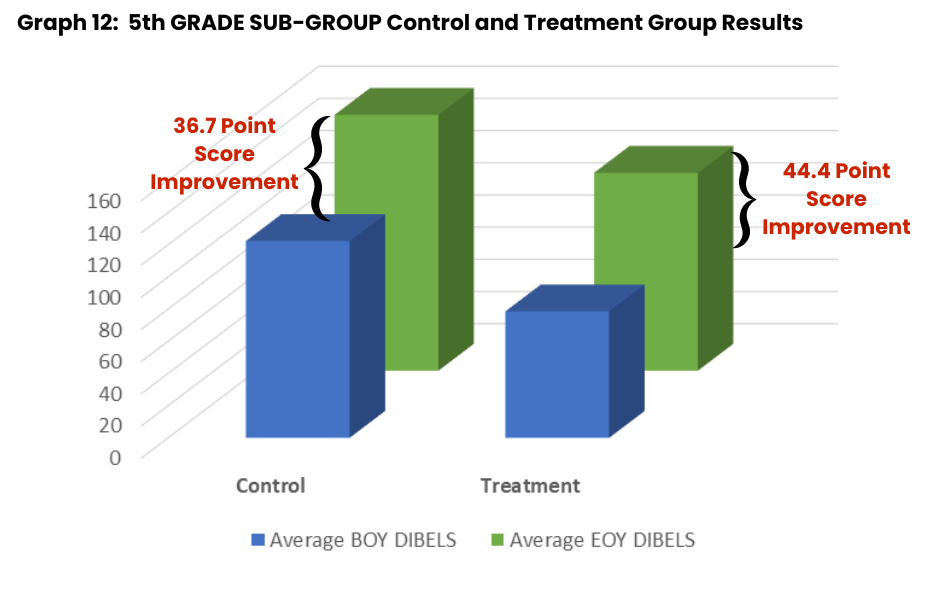FluencyRev™ improving DIBELS Outcomes
FluencyRev™ improving DIBELS Outcomes
On average, over 60% of students in the United States are reading below the proficient level. Based on the 2019 NAEP assessment, 53% of 4th graders scored at or below the Basic level, indicating that they have only partial mastery of the knowledge and skills needed for proficient work at their grade level.
FluencyRev™ is a 100% online oral reading product that gives students access to the proprietary virtual library with leveled readers, that adapt to their ability, in a quest towards improved comprehension. FluencyRev™ is focused on helping children read out loud, to become strong silent readers.
Methodology
Sample
For this study, FluencyRev™, LanguaMetrics, Inc., partnered with Hawaii Educational Resource Experts (H.E.R.E.) and an elementary school in Hawaii. This study aimed to evaluate the effect of reading on FluencyRev™ on student fluency and comprehension when measured with the DIBELS assessment. As of the most recent enrollment data, there are approximately 480 students enrolled in grades K-5. The student demographic at the school is predominantly Asian/Pacific Islander, with nearly 70% of the student population identifying as such. The remaining student population is composed of Hispanic, White, and multi-racial students. The school's student-to-teacher ratio is 17:1, which is slightly higher than the state's average of 15:1. In addition to the regular curriculum, the school also offers special education services and English as a second language (ESL) programs to its students.
Despite being located in a relatively affluent area, a majority of students come from low- income families, with over 60% of students receiving free or reduced-price meals. The school has a dedicated staff that provides additional support to students who may be facing socio-economic challenges. The school also offers extracurricular activities such as music, art, and physical education, as well as after-school programs to ensure that students have access to a well-rounded education.
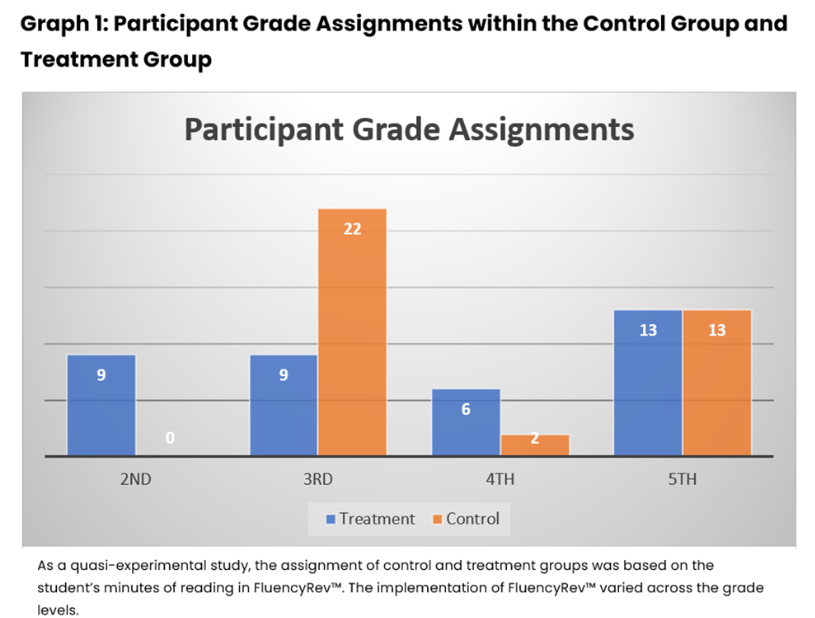
Based on a small pilot in the Spring of 2022, the school decided to offer FluencyRev™ as a reading resource to their second through fifth-grade teachers. The teachers received an hour of refresher training on FluencyRev™ prior to implementation. Fourteen classroom teachers were included in the training, as well as the Curriculum Coordinator. Of the teachers trained, 7 have students in both the treatment and control groups. There are 4 teachers who have students exclusively in the treatment group and 1 teacher that only has students in the control group. Two teachers have students in neither group. The total number of participants in this sample is 74 students in grades 2 through 5.
Procedure
Students completed the progress monitoring assessment in August and the end-of-the-year progress monitoring assessment in May. Upon the completion of the end-of-the-year assessment, the data was collected from FluencyRev™ to analyze student usage within the program based on minutes of reading for the school year.

As a quasi-experimental research, students who read above 60 minutes for the school year on FluencyRev™ were assigned as the treatment group, and students who did not read in the program were assigned to the control group. The grade levels of the sample ranged from 2nd to 5th-grade students. The score and percentile on the beginning of the year assessment score classifications ranged from Cut Point for Risk (Below Benchmark) to Above Benchmark.
Progress Monitoring Measurement
In September, students completed the Dynamic Indicators of Basic Early Literacy Skills, DIBELS, assessment. DIBELS is a set of standardized, brief assessments used to monitor the development of early literacy skills in children from kindergarten through 6th grade. The assessments measure key skills such as phonemic awareness, alphabetic principle, fluency, and comprehension. DIBELS assessments are designed to be administered quickly and easily, with most assessments taking just 1-3 minutes to complete. Results from DIBELS assessments can be used to identify students who may be at risk for reading difficulties, to monitor progress over time, and to inform instructional decisions.
Results
Implementation
Students began using FluencyRev™ after the teachers were trained in September of 2022. This study measures the results of student usage from September 22, 2022, to May 9, 2023, approximately 32 weeks. Although the recommended amount of reading time on FluencyRev™ was 80 minutes, the program gave teachers the freedom to use it in any way they deemed appropriate for their students. The treatment group read an average of 92 minutes within FluencyRev™. The control group did not read in FluencyRev™.
Rev’ing Up Reading with FluencRev™
In September, prior to the implementation of FluencyRev™ the average student score for the treatment group was 64.1 with the students averaging in the 92nd percentile. The average student score for the control group was 107.1 with students averaging in the 97th percentile. Upon completion of the end-of-the-year assessment, the average student score for the treatment group was 116 with the students averaging in the 98th percentile.

The average student score for the control group was 144.95 with students averaging in the 99th percentile. Post-intervention the scores still ranged from Cut-Point for Risk (Well-Below Benchmark) to Above Benchmark.

The following graphs illustrate the baseline and post-intervention score classification make-up of the control and treatment groups.
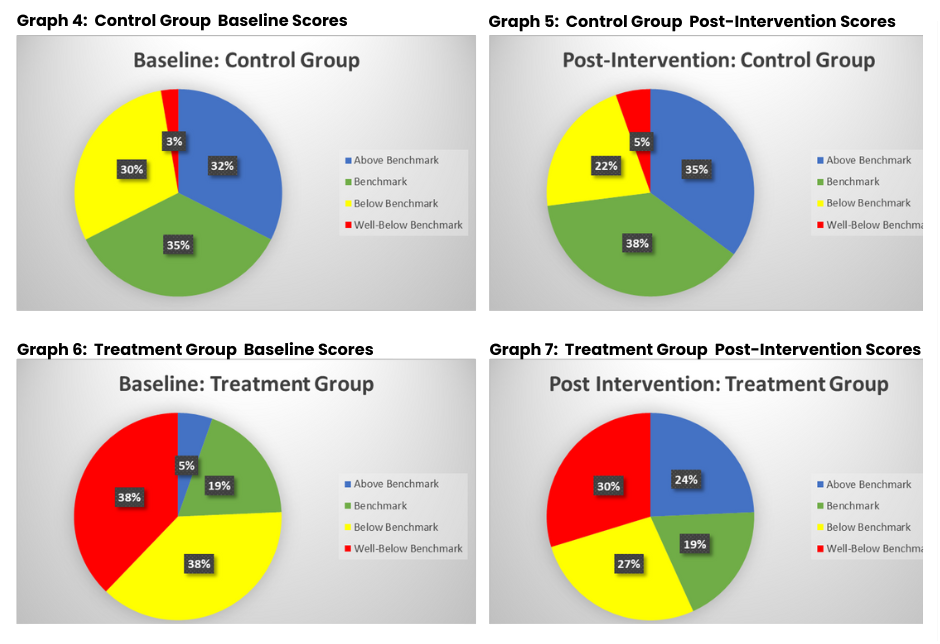

Discussion and Conclusions
The findings of this study strongly suggest the use of FluencyRev™ for oral, guided reading with instant feedback leads to student growth on the DIBELS assessment. The National Reading Panel identified guided repeated oral reading in which students read text out loud multiple times while teachers, peers, or parents provide feedback as the best approach for students to increase their reading fluency (Langenburg, 2000). FluencyRev™ incentivizes students who read books multiple times with stars and coins. Repeated reading leads to an increase in fluency which consequently leads to an increase in student comprehension.

The Graph 9 and Table 3 illustrate the treatment group beginning of the year and end of the year DIBELS scores. Each grade level experienced growth, however, the third grade group grew exponentially higher than other grade levels with a growth of 125%. The average growth for the treatment group was 81%. average growth for the control group was 35%.

Implications for At-Risk Students
Control Group
Students in both groups ranged from Well-Below Benchmark (at-risk) to Above Benchmark. The control group did not use FluencyRev™. Unfortunately, the control group had three students who experienced a regression in their end of the year DIBELS compared to their initial baseline performance. While a few students showed minimal advancements, the overall trend for the students in the Control Group was minimal score increase and no benchmark movement.
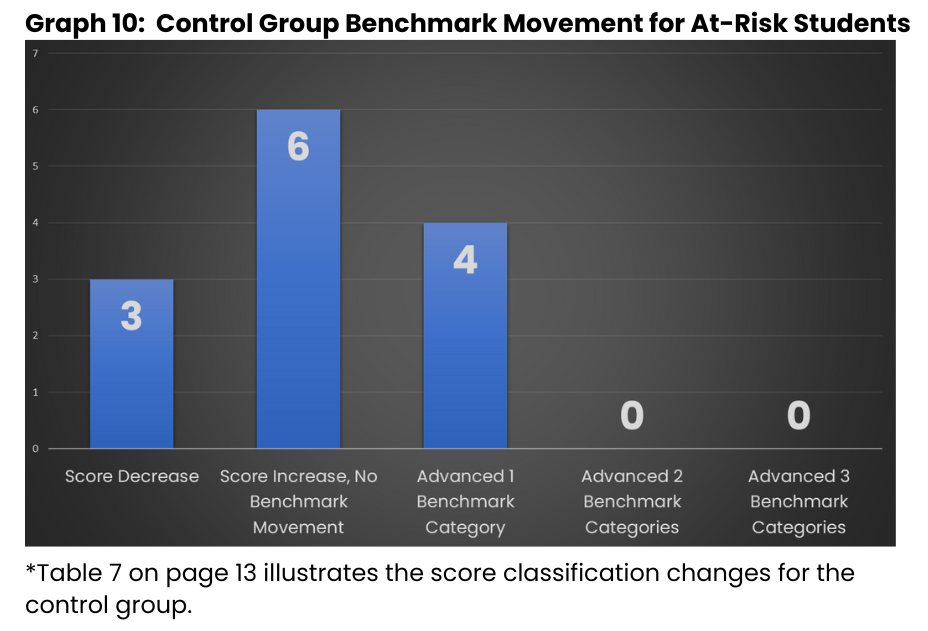
Treatment Group
Students in the treatment group demonstrated significant progression in their reading scores, surpassing the benchmark levels from the beginning of the year. One can conclude that FluencyRev™ effectively supported student reading development, leading to noticeable advancements in their skills and comprehension. These positive outcomes highlight the efficacy of FluencyRev™ fostering growth and achieving desired educational goals. Unlike the control group, the treatment group did not have students regress levels.
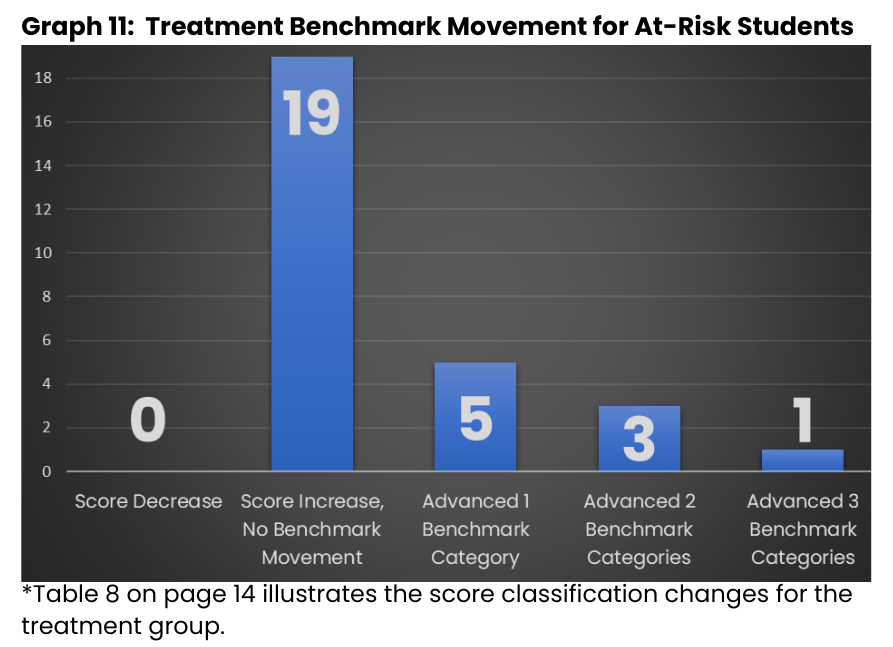
Sub-Group Analysis
For comparison, the 5th-grade students were sampled as a sub-group. For the control group, their beginning-of-the-year average score was 122.3 and the end of the year average score was 159. For the treatment group, their their beginning-of-the-year average score was 78.6 and the end of the year average score was 123. The treatment group read an average of 89 minutes on FluencyRev. The growth of the treatment group was 56% and the control group's growth was 30%. The growth of the treatment group is almost double the growth of the control group.

